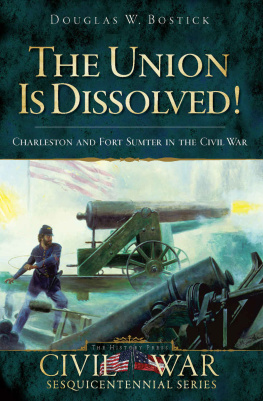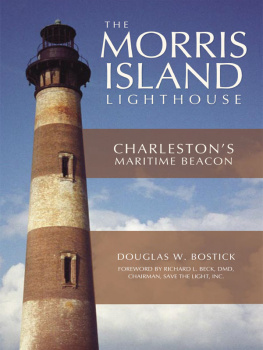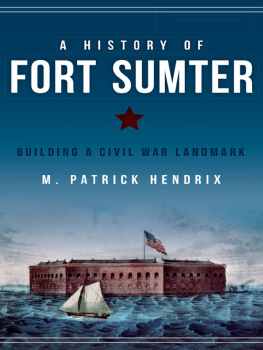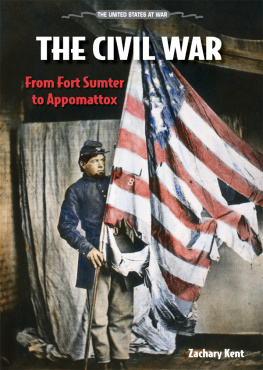T HE U NION
I S D ISSOLVED!
T HE U NION
I S D ISSOLVED!

C HARLESTON AND F ORT S UMTER IN THE C IVIL W AR
D OUGLAS W. B OSTICK

Published by The History Press
Charleston, SC 29403
www.historypress.net
Copyright 2009 by Douglas W. Bostick
All rights reserved
All images are from the authors collection unless otherwise noted.
First published 2009
e-book edition 2011
ISBN 978.1.61423.035.9
Library of Congress Cataloging-in-Publication Data
Bostick, Douglas W.
The Union is dissolved! : Charleston and Fort Sumter in the Civil War / Douglas W. Bostick.
p. cm.
Includes bibliographical references.
print edition: ISBN 978-1-59629-573-5
1. Charleston (S.C.)--History--Civil War, 1861-1865. 2. Fort Sumter (Charleston, S.C.)--Siege, 1861. 3. Secession--Southern States. 4. United States--History--Civil War,
1861-1865--Causes. I. Title.
E471.1.B67 2009
973.7--dc22
2009023234
Notice: The information in this book is true and complete to the best of our knowledge. It is offered without guarantee on the part of the author or The History Press. The author and The History Press disclaim all liability in connection with the use of this book.
All rights reserved. No part of this book may be reproduced or transmitted in any form whatsoever without prior written permission from the publisher except in the case of brief quotations embodied in critical articles and reviews.
This book is dedicated to my dear friend,
Brigadier General Hugh B. Tant III.
He has always conducted himself understanding the greatest calling for any citizenthat of being a Patriot. His only motivation in his illustrious career was to serve his country and his fellow man with honor and integrity. The great spirit of our South Carolina forefathers is exemplified in his conduct, his devotion to duty and his life.
C ONTENTS
A CKNOWLEDGEMENTS
I was raised in the shadow of Fort Sumter. As a kid, my friends and I would ride bicycles to Fort Johnson and gaze out to the harbor onto Fort Sumter. We imagined that we were standing next to the beach battery that fired the first shot. We looked back to the city of Charleston, thinking about the crowds assembled at the Battery to watch the spectacle of war. At low tide, we would walk out from Fort Johnson to Fort Sumter collecting artifacts from the war left behind by the tides.
Visiting our local raconteur, Willie McLeod, at his plantation, he taught us that the proper name for the conflict was the War Between the States. He would often remark that calling it the Civil War implied that states were fighting for control of the country. He would remind us that we (the South) did not want control, we just wanted out!
Though this is my tenth book, it is the first book I ever intended to write. I trust that I have been able to humanize the story of the beginning of the war. War is not romanticwar is no fairy tale. Unfortunately, it is the manner in which we seem to resolve our conflicts.
I am indebted to William Ellis McLeod and my grandfather, J. Frank Taylor, for my early education about the war. In college, I was privileged to take my courses (the American Civil War and the history of the South) from a Citadel professor, Captain Cousins, who would cross town on occasion to teach College of Charleston students about the stories of history he held so dear.
I am indebted to the staff at the Charleston Library Society and the South Carolina Room of the Charleston County Library. Their important collections serve writers and historians well.
Thank you to Laura All, Marshall Hudson and all the staff at The History Press for bringing this important story to print.
Thank you to my wife Karen and my children, Katey, Brooks and Taylor. They have been most tolerant of my fascination with history and writing. They have inspired me to reach out to tell the great stories of our young country.
It is my hope that this modest history will bring readers to want to know more about the fascinating people who played a role in this American drama. Their lives are worthy of study. Their stories deserve to be told.
C HAPTER 1
T HE P RINCIPLES OF
S ELF -D ETERMINATION
Secession is not a concept of the nineteenth century. The use of force to hold a political union is almost as old as man himself. Interestingly, almost all the attempts to secede have met with failure, in many cases, with disastrous results.
In the fourth century BC, the city-states of Melos and Mytilene attempted to secede from the Athenian League. The revolt was over heavy taxes imposed by Athens. The revolt was put to bed by a brutal war, which proved a lesson to the other city-states. Later, Rome dealt with many attempts through its history of rule.
In the modern era, the Dutch revolt against the Spanish empire initiated sixty years of war. The struggle of Scotland to gain independence from England foreshadowed the events in America centuries later. The Scots battled for five hundred years and finally ended with the Act of Union in 1707. The Disarming Act of 1756 revoked the Scots right to bear arms. It also banned the use of bagpipes and the wearing of tartans. The Scottish quest for independence can be traced back to 12971320 and the Declaration of Arbroath, which stated:
So long as there shall be but one hundred of us to remain alive we will never give consent to subject ourselves to the dominion of the English. For it is not glory, it is not riches, neither is it honor, but it is freedom alone that we fight and contend for, which no honest man will lose but with his life.
One British officer, known as Butcher Cumberland, laid waste to the Scottish Highlands, not unlike the march of Sherman to the sea in Georgia.
Of course, another long-standing story of independence is the struggle of Ireland. The battle for Irish secession has lasted for almost four hundred years and is still not fully resolved.
The great irony, of course, of the furor over the secession movement in America is that the creation of the very government that fought to prevent secession was born of secession. That fact was not lost on the British when the NorthSouth conflict emerged in America. The right of a people by popular consent to secede from a larger nation or confederation when the people believed it no longer served their needs and interests is the story of the American Revolution. One British scholar wrote, It is startling to realize that Lincoln did not believe in the principle of self-determination of peoplesLincoln fought against them with more determination than any British Prime Minister fought against Ireland.
The idea of secession was born in America, though, long before 1860. Massachusetts threatened to secede four times in the history of the young country: over state debts after the Revolution, after the Louisiana Purchase by Jefferson, during the War of 1812 and finally on the annexation of Texas. Unlike Lincoln, Jefferson acknowledged the right of secession if that was the will of Massachusetts.
When ratifying the United States Constitution, Rhode Island, New York and Virginia all retained the right to leave the United States if needed. The Virginia Act, approved on June 26, 1788, stated: In their name and on behalf of the people of Virginia, declare and make known, that the powers granted under the Constitution, being derived from the people of the United States, may be resumed by them, whenever the same shall be perverted to their injury or oppression.











